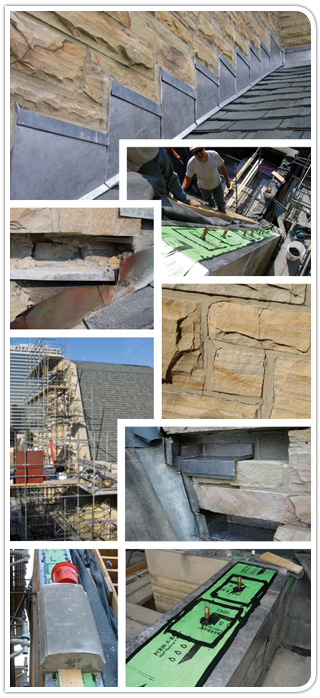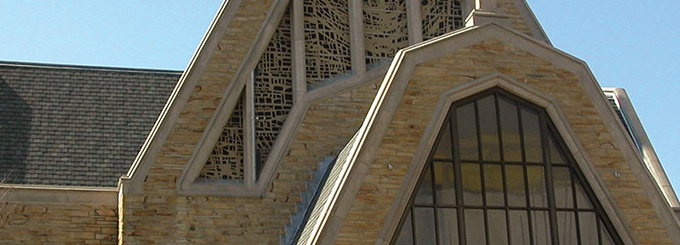First Presbyterian Church
Winston-Salem, North Carolina
Church Masonry Restoration
Project Background
- Completed in 1974, First Presbyterian Church was constructed using a hybrid masonry wall consisting of CMU backup with a mortar-filled collar joint separating the backup wall and ashlar coursed sandstone facing
- The church’s sanctuary is constructed in a crucifix configuration with a center steeple
- Designed as a crucifix in plan, the sanctuary extends to each compass point and is terminated on the exterior with a masonry gambrel gable
- Richly detailed masonry includes cut Indiana limestone copings and complex window surrounds at intricate stained glass features
- Years of continual interior leakage had caused staining and degradation of the masonry walls and interior finishes
Project Challenges
- Access for evaluation and repair was difficult because of a tight center city location and numerous adjoining building additions
- After extensive testing by SKA Consulting Engineers, a multi-phase repair project, including masonry repairs, roof replacement, and steeple repair, was instituted
- To receive the best value, system scaffolding was used to support all trades, minimizing both costs and project duration
Project Approach
- To make the hybrid masonry wall water-resistant, extensive new flashing was installed at all rising walls and above masonry limestone trim components
- All limestone coping components were removed and lead-coated copper through-wall flashings were added; flashings included a projecting copper receiver to accommodate removable counterflashing that integrated multiple roof interfaces
- Complex step flashing was installed at all rising wall interfaces, which was complicated by variations in the random sizing of sand stone ashlar masonry
- Each step pan flashing included a projecting counterflashing receiver and foam drainage weep integrated for optimal performance

“MPS stands alone when it comes to issues related to masonry and water intrusion. It is invaluable having their assistance during the conceptual phase of developing feasible and constructible solutions. Their in-house technical expertise, as well as the skills, knowledge, and experience of their field personnel, is a true asset in assuring effective long-term outcomes.”
Robert G. Kennerly, Sr., P.E.
Senior Engineering Consultant
SKA Consulting Engineers, Inc.
